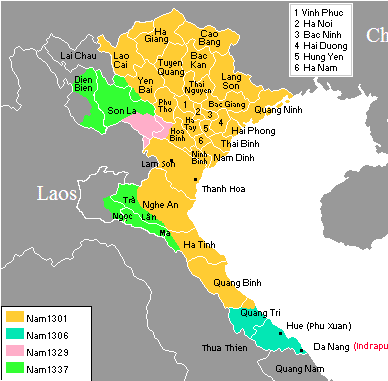Thuận Hóa on:
[Wikipedia]
[Google]
[Amazon]
Thuận Hóa (, ) was a historic territory in central  The
The
Vietnam
Vietnam or Viet Nam ( vi, Việt Nam, ), officially the Socialist Republic of Vietnam,., group="n" is a country in Southeast Asia, at the eastern edge of mainland Southeast Asia, with an area of and population of 96 million, making i ...
. It consisted of the modern provinces of Quảng Bình, Quảng Trị, and Thừa Thiên–Huế (historically, Thừa Thiên–Thuận Hóa).
In 1306, the king of Champa, Che Man, offered Vietnam two Cham prefectures, Ô (Cham:Vuyar) and Lý (Cham: Ulik), in exchange for a marriage with the Vietnamese princess Huyền Trân
Princess Huyền Trân (, 玄 珍 公 主) (1289-1340) was a princess of the Trần Dynasty of Đại Việt, who later married to King Jaya Simhavarman III of Champa and titled queen consort Parameshvari of Champa from 1306 to 1307.
Biography
...
.Chapius, p. 85. The Vietnamese emperor Trần Anh Tông
Trần Anh Tông ( vi-hantu, 陳英宗, 17 September 1276 – 12 December 1320), personal name Trần Thuyên (陳烇), courtesy name Nhật Sủy (日煃) or Nhật Sáng (日㷃/日𤊞), was the fourth emperor of the Trần dynasty, reigning ov ...
accepted this offer, then took and renamed Ô prefecture and Lý prefecture as Thuận prefecture and Hóa prefecture. These prefectures soon began to be referred to collectively as the Thuận Hóa region. From this time, Thuận Hóa was a territory where the Vietnamese, Chăms, and Lao frequently fought one another. In 1466, during the reign of emperor Lê Thánh Tông, Thuận Hóa became one of the 12 prefectures of Vietnam and later became a province of Vietnam.
 The
The Mạc dynasty
The Mạc dynasty ( vi, Nhà Mạc / ''Mạc triều''; Hán Nôm: 茹莫 / 莫 朝) (1527-1627), as known as House of Mạc ruled the whole of Đại Việt between 1527 and 1540 and the northern part of the country from 1540 until 1593, and ...
usurped the throne of the Lê family to create the Northern Court, whereupon descendant of the Lê kings was enthroned as ''de jure
In law and government, ''de jure'' ( ; , "by law") describes practices that are legally recognized, regardless of whether the practice exists in reality. In contrast, ("in fact") describes situations that exist in reality, even if not legally ...
'' Southern court rulers by Nguyễn Kim. Shortly afterward, Nguyễn Kim, the leader of the Lê dynasty loyalists and the ''de facto
''De facto'' ( ; , "in fact") describes practices that exist in reality, whether or not they are officially recognized by laws or other formal norms. It is commonly used to refer to what happens in practice, in contrast with ''de jure'' ("by la ...
'' ruler of Vietnam, was poisoned by a Mạc dynasty general. Kim's son-in-law, Trịnh Kiểm, took over the leadership and assassinated Kim's eldest son, Nguyễn Uông, in order to secure his authority. Nguyễn Hoàng
Nguyễn Hoàng (28 August 1525 – 20 July 1613) was the first of the Nguyễn lords who ruled the southern provinces of Vietnam between 1558 and 1613, from a series of cities: Ai Tu (1558–70), Tra Bat (1570–1600), and Dinh Cat (modern-day H ...
, another son of Nguyễn Kim, feared having a fate like his brother Nguyễn Uông so he pretended to have mental illness and asked his sister Ngoc Bao, who was a wife of Trịnh Kiểm, to entreat Kiểm to allow Hoàng to govern Thuận Hóa, the southernmost region of Vietnam at this time. Because Mạc dynasty loyalists were still occupying Thuận Hóa while Trịnh Kiểm was busy fending off Mạc forces in northern Vietnam during this time, Ngoc Bao's request was approved and Nguyễn Hoàng went south.Phan Khoang, pp. 108-110. After Hoàng pacified Thuận Hóa, he and his successor Nguyễn Phúc Nguyên secretly made this region loyal to the Nguyễn family; then they rose against the Trịnh Lords. Vietnam erupted into a new civil war between two ''de facto'' ruling families: the clan of the Nguyễn lords and the clan of the Trịnh lords
The Trịnh lords ( vi, Chúa Trịnh; Chữ Nôm: 主鄭; 1545–1787), formal title Trịnh Viceroy (; ), also known as Trịnh clan (鄭氏, ''Trịnh thị'') or the House of Trịnh, were a noble feudal clan who de facto ruled Northern Viet ...
. The Nguyễn lords continuously developed the territory and turned it into a strong base for their war against the Trịnh Lord and their expansion to the south. During this time, Thuận Hóa territory spanned from Quảng Bình to Thừa Thiên–Huế.
After the foundation of Nguyễn dynasty, emperor Gia Long made Thuận Hóa territory a part of ''Vùng Kinh kỳ'' (Capital territory), one of three administrative divisions of Vietnam at this time.
In the 18th Century Thuận Hóa and Quảng Nam ceased producing much rice of their own and became dependent on shipments of cheaper rice from the Mekong Delta.
1945
In mid-1945; the name of Thuận Hóa was restored by Vietnamese prime minister Trần Trọng Kim but it was quickly abandoned after the decline of the Empire of Vietnam.Other names
In the West, Thuận Hóa was also known by the Portuguese, and later French, as Sinoa, Singoa, or Senna - reflecting European knowledge of Chinese pronunciations of the name (Chinese 順 化 ''Shunhua'') possibly by contact with Chinese traders inĐàng Trong
Đàng Trong ( vi-hantu, , lit. "Inner Circuit"), also known as Nam Hà (, "South of the River"), was the South region of Vietnam, under the rule of the Nguyễn lords, later enlarged by the Nam tiến, Vietnamese southward expansion. The word '' ...
(Sino-Vietnamese 塘中, part of Cochinchina).Tana Li, ''Nguyễn Cochinchina: Southern Vietnam in the Seventeenth and Eighteenth Centuries'' Cornell University. Southeast Asia Program - 1998 Page 173 "Sinoa, or Senoa, should refer to ''Shunhua'', a Chinese pronunciation for Thuận Hóa. It might have been taken by "
Notes
References
* * * * * * __NOTOC__ {{DEFAULTSORT:Thuan Hoa Nguyễn lords